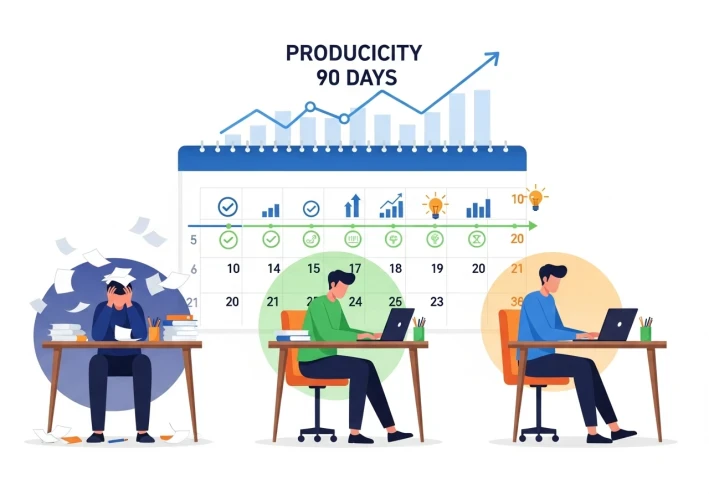
The 90-Day Productivity Transformation,
The 90-Day Productivity Transformation: A Comprehensive Guide to Unleashing Your Full Potential
Introduction: A Journey Towards Unprecedented Productivity
Do you sometimes feel like you're stuck in a rut? Do you put in a lot of effort without achieving the desired results? If your answer is yes, you are not alone. Many face this challenge in our fast-paced world.
Achieving a productivity transformation is not just a distant dream. It's an achievable goal through a well-thought-out plan. This plan requires a real commitment from you. In this article, we will provide you with a comprehensive guide.
This guide will help you unleash your hidden potential. You will focus on achieving your goals within a specific timeframe. This period is 90 days. These days will be enough to make a significant difference in your professional and personal life.
Imagine being able to double your productivity. Imagine completing your tasks with unprecedented efficiency. This is not fiction, but a reality you can create. It requires a clear methodology and diligent follow-up.
Together, we will explore every step of this journey. From strategic planning to sustainable success. You will learn how to define your goals precisely. You will know how to manage your time with maximum effectiveness. Get ready for a life-changing journey.

1. Understanding the 90-Day Productivity Transformation
1.1 What is Productivity Transformation?
Productivity transformation is a structured process. It aims to radically improve your efficiency and effectiveness. It's not just about increasing the number of tasks completed. It's also about improving the quality of achievements. It's about working smarter.
This process involves changes in habits and behaviors. It aims to make the most of your time and resources. It's a personal journey towards excellence. It will help you achieve your major goals. You will feel continuous satisfaction and accomplishment.
1.2 Why 90 Days?
The 90-day period is not arbitrary. It's an ideal duration for real change. It's long enough to build new habits. And it's short enough to maintain momentum and focus. It's a challenging period.
This period gives you a clear timeframe. Through it, you can accurately measure your progress. It also helps you avoid procrastination. You can break down your big goals into smaller ones. These goals can be achieved in each stage of the 90 days.
It's an opportunity to re-evaluate your priorities. You can reset your path towards success. Remember that commitment is the key to this journey. Every day that passes is a step towards your most productive self. Use every moment wisely.
2. Phase One: Strategic Planning (Days 1-30)
The first thirty days are the cornerstone. This is the period where you lay a solid foundation. This foundation will ensure the success of your productivity transformation. Without proper strategic planning, you might lose your way.
2.1 Clearly Defining Goals
The first and most important step is goal setting. Your goals must be clear and specific. Use the SMART criteria for goals. This means your goals should be Specific, Measurable, Achievable, Relevant, and Time-bound.
- Specific Goals: What exactly do you want to achieve? Avoid generalities. Be as precise as possible. For example, instead of "increase sales," say "increase sales by 15%."
- Measurable Goals: How will you know you've achieved your goal? There should be clear indicators. These indicators allow you to track progress. Numbers and percentages are useful here.
- Achievable Goals: Is your goal realistic? Do you have the necessary resources to achieve it? Set ambitious but possible goals. Don't put yourself under unnecessary pressure.
- Relevant Goals: Does your goal align with your bigger vision? Is it important to you? Make sure your goals serve a deeper purpose. This will increase your motivation.
- Time-bound Goals: When do you want to achieve this goal? Set a clear deadline. This creates a sense of urgency. It helps you stay on track.
Before starting, you need to understand where you currently stand. Conduct a comprehensive analysis of your current situation. What are your strengths? What are your weaknesses? What opportunities are available? What challenges do you face?
- Skill Assessment: What skills do you possess? Do you need to develop new skills? Identifying gaps helps you plan for training.
- Time Analysis: How do you currently spend your time? Use a time log. Track your activities for a week. You'll be surprised by the amount of wasted time. This analysis will reveal a lot.
- Identifying Obstacles: What prevents you from being more productive? Is it distractions? Is it a lack of organization? Identifying these obstacles is the first step to overcoming them.
Once you've defined your goals and analyzed your situation, it's time to create the plan. Your plan should be detailed and clear. Break down your big goals into smaller tasks. These tasks should be actionable daily or weekly.
- Prioritization: Use the Eisenhower Matrix. Divide your tasks into urgent and important. Focus on important but non-urgent tasks. These are the tasks that drive you towards your goals.
- Resource Allocation: What resources do you need? Are they tools? Is it information? Is it help from others? Make sure everything necessary is available.
- Setting a Timeline: Set deadlines for each task. Be realistic in estimating time. Leave room for flexibility. Life is full of surprises.
- Defining Key Performance Indicators (KPIs): How will you measure your progress? Set clear indicators. These indicators will help you with continuous evaluation. You'll know if you're on the right track. This ensures you achieve your goals efficiently.
Remember that this phase is the foundation. The stronger your foundation, the more successful your productivity transformation will be. Invest your time and effort wisely in these first thirty days. You will reap the rewards later.
3. Phase Two: Execution and Focus (Days 31-60)
After setting your meticulous plan, it's time for execution. This phase is the core of productivity transformation. Here, ideas turn into actions. Days 31 to 60 are a period of hard work. You will test your ability for deep focus.
3.1 Effective Time Management
Time management is the key to productivity. It's not just about organizing tasks. It's the art of allocating your time wisely. This ensures you make the most of every minute. There are many techniques you can use.
- Pomodoro Technique: Work for 25 minutes with full concentration. Then take a 5-minute break. Repeat this cycle four times. After that, take a longer break. This technique enhances deep focus.
- Two-Minute Rule: If a task takes less than two minutes, do it immediately. Don't postpone it. This prevents small tasks from accumulating. And it reduces mental clutter.
- Time Blocking: Allocate specific time blocks for certain tasks. For example, an hour for answering emails. Two hours for working on a major project. This reduces distractions.
- Daily Prioritization: At the end of each day, identify the top 3 tasks for the next day. Start with them in the morning. This ensures you complete the most important tasks first. And it gives you a sense of accomplishment.
In a world full of distractions, deep focus has become a rare skill. It's the ability to concentrate on a single task. Without any interruptions. This leads to higher quality work. And faster completion of complex tasks.
- Eliminating Distractions: Turn off notifications on your phone and computer. Find a quiet place to work. Inform those around you that you need time to focus. The less distraction, the more focus.
- One Task at a Time: Avoid multitasking. Focus on completing one task entirely. Then move to the next task. This increases your efficiency. And reduces errors.
- Regular Breaks: Rest is essential for maintaining deep focus. Don't work for long hours without stopping. Take short breaks. Change your activity during them. This refreshes your mind.
- Identifying Peak Times: Know the times when you are most productive. Allocate these times for tasks that require deep focus. Utilize your maximum energy.
Productivity transformation relies on habits. Habits are behaviors that repeat automatically. Building new productive habits takes time and effort. But it's worth it. They will become an integral part of your routine.
- Start Small: Don't try to change everything at once. Start with one small habit. For example, dedicate 15 minutes to reading every morning. Once you master it, add another habit.
- Consistency: Consistency is the most important thing. Even if the duration is short. Practice the new habit every day. Even on days when you don't feel like it. This builds momentum.
- Reward: Reward yourself when you stick to a new habit. Rewards reinforce positive behavior. And make you want to continue. The reward can be simple.
- Tracking Progress: Use an app or notebook to track your habits. Seeing your progress is a great motivator. This shows you how committed you are. And encourages you to keep going. This contributes to continuous personal growth.
You have now reached the final phase of your productivity transformation journey. Days 61 to 90 are a crucial period. They are dedicated to continuous evaluation and adaptation and flexibility. This phase ensures the sustainability of your progress.
4.1 Continuous Performance Evaluation
It's not enough to work hard. You must work smart. This requires continuous evaluation of your performance. Look at what you've accomplished. Compare it to your initial goals. Are you on the right track?
- Goal Review: At the end of each week, review your goals. Did you achieve what you planned? What went well? What didn't go as expected? Be honest with yourself.
- Data Analysis: If you use tools to track your productivity, analyze the data. What patterns do you notice? Are there specific times when you are more productive? Are there tasks that take longer than you expected?
- Seeking Feedback: Don't hesitate to ask for feedback from colleagues or supervisors. External perspectives can be valuable. They might notice things you don't. Use this feedback to improve your performance.
- Identifying Areas for Improvement: Based on your evaluation, identify areas that need improvement. This might be a new skill. It might be a different way of working. Focus on continuous improvement.
Life doesn't always go according to plan. You will face challenges and obstacles. This is where the importance of adaptation and flexibility comes in. Don't blindly stick to your plan. Be prepared to adjust it when necessary.
- Learning from Mistakes: Mistakes are not failures. They are opportunities to learn. Analyze the mistakes you made. What could you do differently next time? Turn challenges into lessons.
- Adjusting Goals: You might need to adjust your goals. Some goals might be unrealistic. Or your priorities might change. Don't be afraid to change course. The most important thing is to keep moving forward.
- Seeking Alternative Solutions: If you encounter an obstacle, don't give up. Look for alternative ways to achieve your goal. Think outside the box. Consult others. Creativity generates solutions.
- Maintaining Positivity: Maintain a positive attitude. Challenges are a natural part of any journey. Positivity helps you overcome difficulties. And increases your ability for adaptation and flexibility. This fosters personal growth.
It's important to celebrate your achievements. Even if they are small. This boosts your motivation. And gives you a sense of satisfaction. You should also learn from the challenges you faced.
- Celebrating Achievements: Take time to celebrate every goal you achieve. Reward yourself. Share your successes with others. This boosts your self-confidence. And encourages you to continue.
- Reflecting on Challenges: After every challenge, take time to reflect. What did you learn? How can you apply this lesson in the future? Challenges make you a stronger person.
- Documenting the Journey: Keep a record of your journey. Write about your successes and challenges. This record will be a valuable reference for you. It will inspire you in the future. And it will help you remember how far you've come.
This phase is the culmination of your efforts. It ensures that your productivity transformation is not just a temporary boost. But a permanent change for the better. Get ready for the next phase: sustainable success.
5. Beyond 90 Days: Sustainable Success and Personal Growth
You have completed your 90-day productivity transformation journey. Congratulations! This is not the end. It's the beginning of a new phase. A phase of sustainable success and continuous personal growth. How do you maintain this momentum?
5.1 Maintaining Momentum
Maintaining momentum is more important than starting. The new habits you've built are your asset. You must continue to practice them. This ensures your productivity doesn't decline. Instead, it continues to rise.
- Daily Routine: Maintain your daily routine. Routine reduces the need for decision-making. This saves your mental energy. And makes productivity a natural part of your day.
- Setting New Goals: Once you achieve your goals, set new ones. Goals give you motivation. And guide your efforts. Make your next goals more ambitious. Keep challenging yourself.
- Accountability: Find an accountability partner. It can be a friend or a colleague. Share your goals and progress. This increases your commitment. And gives you additional support.
- Regular Review: Continue to review your progress regularly. Not just every 90 days. But monthly or weekly. This helps you with continuous evaluation. You can adjust your course if necessary.
Personal growth is an ongoing journey. Productivity transformation is part of it. Continue to develop yourself. Learn new skills. Read books. Attend workshops. Invest in yourself.
- Continuous Learning: The world is changing rapidly. You must change with it. Dedicate time to learning. Whether it's a new skill. Or new knowledge. Learning opens new horizons for you.
- Skill Development: Identify the skills you need. To be more productive. Or to achieve your future goals. Work on developing them regularly. Skills are your real investment.
- Health Care: Your physical and mental health affect your productivity. Get enough sleep. Eat healthy food. Exercise regularly. Take care of your mental health. This enhances deep focus.
- Meditation and Self-Awareness: Dedicate time to meditation. Or to practicing self-awareness. This helps you understand yourself better. You can identify your strengths and weaknesses. And it helps you with adaptation and flexibility.
When productivity becomes part of your identity, you build a legacy. This legacy is not limited to your personal achievements. It extends to your impact on others. Be an inspiration to those around you.
- Sharing Experiences: Share your story with others. Talk about your productivity transformation journey. Offer advice. Be a mentor. Your experience can inspire many.
- Building a Community: Join communities interested in productivity. Or create your own community. Exchange ideas. Support each other. Community enhances commitment.
- Being a Role Model: Be a good role model. Show others how productivity can be achieved. Through hard work. And proper planning. And continuous commitment. Your actions speak louder than your words.
- Positive Impact: Use your productivity to make a positive impact. In your work. In your community. In your personal life. Productivity is not an end in itself. It's a means to achieve bigger goals. This ensures sustainable success.
You have come a long way in understanding the 90-day productivity transformation journey. This is not just a theory. It's a practical methodology. You can apply it in your life. To unleash your full potential. And exceed your expectations.
Remember that success is not a destination. It's a continuous journey. It requires precise strategic planning. And effective time management. And deep focus on essential tasks. And continuous evaluation of your performance. And adaptation and flexibility with challenges.
The keywords we discussed are your keys. Keys to open new doors. Doors to personal growth and sustainable success. Don't miss the opportunity. Start today. Plan your next ninety days.
Make them days full of achievement. Days where you make a real difference. In your life. And in the lives of those around you. You have the power to change. You have the power to be more productive. Go now. Towards a brighter future.




























